

Reconstitutions. Nous avons vu quelques points de broderie de l'époque, des techniques appliquées à la broderie, les costumes des artisans et les outils.
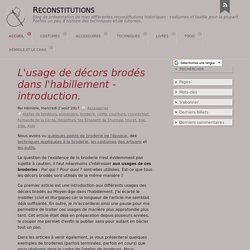
La question de l'existence de la broderie n'est évidemment pas sujette à caution, il faut néanmoins s'intéresser aux usages de ces broderies : Par qui ? Pour quoi ? Sont-elles utilisées. Est-ce que tous les décors brodés sont utilisés de la même manière ? Ce premier article est une introduction aux différents usages des décors brodés au Moyen-âge dans l'habillement. Dans les articles à venir également, je vous présenterai quelques exemples de broderies (parfois terminées, parfois en cours) que nous réalisons dans le cadre de l'atelier de brodeurs.
Si l'atelier de brodeurs et les brodeurs eux-mêmes sont fixés dans une aire spatio-temporelle, les ouvrages proposés sont d'origine plus étendue. Introduction : les décors brodés comme marqueur social et symbolique. One Englishwoman's work. - Moyen Age femmes « Coiffures du Passé - Galerie de dessins de coiffures historiques.
Historické kostýmy a střihy. Perline la Tisserande, Nouveau blog. Albums de Andre de Montsegur sur Flickr. Atlantian A&S Links: Main. Or, mathildegirlgenius Plays With Wordpress. Extant Medieval Resources Page. Undefined Last updated on: 3/25/08.

Note, every page is complete at this time; if you see any errors, please let me know. My husband and I went on our honeymoon in March of 2007 to England and Scotland. Of course, we took pictures along the way. Being medieval re-enactors in the SCA, we tried to hit as many medieval museums, churches and castles as we could along the way. Anyways, I thought I would share with re-enactors back home in the U.S. some of the fascinating things that we saw while in Britain. A warning, before you get into the pictures: we had a very hard time getting good pictures.
In any event, here are some of our pictures and my comments/analysis. Medieval and Roman JewelryMedieval Fabric Pieces (including knit)Medieval Shoes, Pattens and Misc. Questions about something you've seen? Sir Ian Stuart MacDonald is a 14th century Scottish knight, earning his keep by killing Frenchmen and Eastern European pagans. Burgundian Costume.
The Bernard Strigel Necklace – as close as I can get it. I very rarely try to make replicas of anything, it is actually something I try NOT to do, as I just don’t have the skills or the materials to make something really similar.
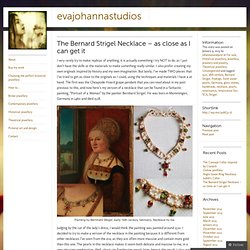
I also prefer creating my own originals inspired by history and my own imagination. But lately, I’ve made TWO pieces that I’ve tried to get as close to the originals as I could, using the techniques and materials I have a at hand. The first was the Cheapside Hoard grape pendant that you can read about in my post previous to this, and now here’s my version of a necklace that can be found in a fantastic painting, “Portrait of a Woman” by the painter Bernhard Strigel. He was born in Memmingen, Germany in 1460 and died 1528. Painting by Bernhard Strigel, early 16th century, Germany. Judging by the cut of the lady’s dress, I would think the painting was painted around 1510. Enjoy the photos below. Back view of the pendant.
Filet - boursedestello. Burgundian-reference. Lorliaswood.fr. La cotte simple - Late medieval fashion redressed. Time Traveling with Needles. 10 Tips to Look More Medieval. Yes, it usually requires a goodly outlay of cash, but nothing attracts admirers like a fancy brocade or real fur.
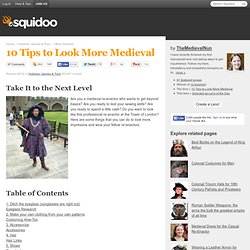
If you take your time and really hunt, you can sometimes catch a decent price on brocade (I got some once for $5/yard). Also, if you go to yard sales and flea markets, you can sometimes get old fur coats for cheap, which can be cut up and pieced back together to make sideless surcoat tops or the lining of a short mantle. Even if you can’t afford a lot of brocade or fur, you can get a lot of the value of it by using it selectively.
You can get a small piece of rabbit fur from a leather goods shop and put fur trim around sleeves or collar, or line a hood or hat. You can get a one yard remnant of brocade and make detachable sleeves, as I mentioned above, or make undersleeves to a short-sleeved cotehardie. Fake fur is better than no fur at all, and is all that will work in some places. Artifex - Szycie strojów historycznych, fantasy, tanecznych, gotyckich. Rzemiosło historyczne - kostiumy, namioty. Womens Medieval Clothing. Romantic History. A few weeks ago my mother in law came by and handed me a plastic grocery bag.
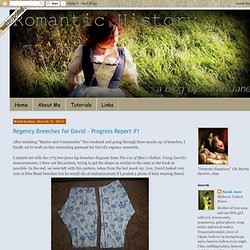
It was one of her thrift store "finds". She is the Queen of Thrift and finds amazing deals. This one was a 3 yard length of high quality green and white polka dot cotton. It was lovely. Romantic History. Our annual 12th Night party was held on Saturday night.
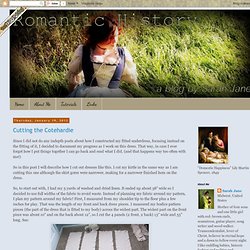
David had to work for half of the day so we had a late start getting there. In fact, I wasn't even sure that we were going to be able to go. I was thwarted at every turn. I couldn't find anything we needed. The wrapping paper and tape for our contributions to the gift exchange. I did finally find enough to get us clothed - although we looked a bit rumply, and the children had to wear modern shoes and pants beneath their tunics - and we packed into the van and made it just after court started. We did end up having a nice time, though.
I didn't get any pictures save one, of my right-side dinner companion, Mr. These other pictures are ones I had David take right before we left home, because I wanted everyone to be able to see the beautiful gift I received last month. I love how it looks with my dress; so much so I decided against wearing my surcote so the pin keep wouldn't be covered up underneath it! Love, Sarah. Diu Minnezît - 1350. Time spent with resting hands is time wasted. FireStryker Living History Forum : Tablet Woven Belt for my Gown. Raymond's Quiet Press. Cauls, Truncated and Butterfly Henins, and theories. <map name="admap53533" id="admap53533"><area href=" shape="rect" coords="0,0,468,60" title="" alt="" target="_blank" /></map><table cellpadding="0" border="0" cellspacing="0" width="100%" bgcolor="#ffffff"><tr><td align="right"><img src=" width="468" height="60" usemap="#admap53533" border="0" alt="" /></td></tr><tr><td bgcolor="#ffffff" colspan="1"><center><a style="font-size:10px;color:#0000ff;text-decoration:none;line-height:1.2;font-weight:bold;font-family:Tahoma, verdana,arial,helvetica,sans-serif;text-transform: none;letter-spacing:normal;text-shadow:none;white-space:normal;word-spacing:normal;" href=" target="_blank">Ads by Project Wonderful!
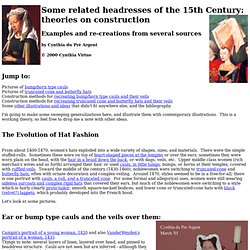
Your ad here, right now: $0</a></center></td></tr><tr><td colspan="1" valign="top" width="468" bgcolor="#000000" style="height:3px;font-size:1px;padding:0px;max-height:3px;"></td></tr></table> Examples and re-creations from several sources by Cynthia du Pré Argent © 2000 Cynthia Virtue Jump to: The Evolution of Hat Fashion. Racaire's Embroidery & Needlework…
…well, here you can see the second part of my seam treatment of the seam around the face opening of my hood – unfortunately the picture of step one didn’t turn out well. The first step was to fold the edge of the fabric to the inside and to sew the edge to the fabric with small stitches while laying in a thread next to the edge… If my description seems a little bit unclear (sorry, English is not my mother tongue) or you have questions to this seam treatment – please scroll down to the last picture of this post where I took a photo of my finished seam and two rather similar schematic drawings of this technique from two of my books to give you a better idea of this technique… …and here a better picture of part 2 of the seam treatment – small stitches near to the edge of the seam which make the seam edge very flat – especially nice when you use rather bulky wool, this is a nice technique to flatten your seam and another plus – it also looks very decorative …and one picture of the inside out…
Fief et chevalerie.